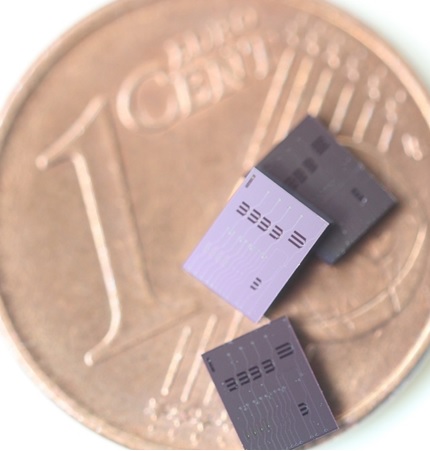IHP - With “HOPBIT” into the future

With “HOPBIT”, the Leibniz Institute for Innovative Microelectronics (IHP) from Frankfurt (Oder), came up with a very memorable name for their research project. The acronym HOPBIT stands for “Hybrid Silicon-Organic Photonics for High Bit Rate Data Transmission”, which in practice means energy-efficient data transmission.
Since 2017, the HOPBIT project has been researching a new way of data transmission. In doing so, the competences and resources of the IHP in Frankfurt (Oder) and the Technical University of Applied Sciences in Wildau are effectively used. The IHP has already received funding from the European Regional Development Fund (ERDF) several times, including for research on this project topic, which has extremely high scientific, social and ecological benefits. The microchip developed by the IHP is to be used primarily in server farms, where it will optimise data transmission. Especially the reduction of energy consumption is a key objective of this project.
How exactly does data transmission change?
We all generate data every day. The data is often transmitted over long distances, for instance, when a vacation picture is sent to the family or a query is entered into a search engine. The data is transmitted at incredible speed via fibre optic cables. When the data arrives in the cities and communities, it is converted into a wireless signal that can then be used by smartphones. In fibre optic technology light is used to transmit information. This very data transmission must be optimised. The HOPBIT project is using a combination of silicon and organic material to achieve this aim.
“Silicon is the driving element of microelectronics”, says the head of the technology department at the IHP Professor Andreas Mai. But a microchip has its limits when it comes to speed and energy consumption. At the IHP, synergy effects between silicon and organic material are used to create a more powerful and less energy-consuming chip, which then controls the encryption and decryption during data transmission. The chip is located in front of the fibre optic cable, encrypts the data to be transmitted into a light frequency and decrypts it again on the other end of the line. This happens about a billion times faster than we are able to switch a light on and off. The innovative chips are placed on a so-called “wafer”, a base plate for electronic components.
Promoting young talents is a priority
The interdisciplinary project promotes students’ education. Junior scientists can participate in all sub-areas of the project, while working on current development problems and gaining more in-depth knowledge of content and methodology.
For further information, visit www.ihp-microelectronics.com
Since 2017, the HOPBIT project has been researching a new way of data transmission. In doing so, the competences and resources of the IHP in Frankfurt (Oder) and the Technical University of Applied Sciences in Wildau are effectively used. The IHP has already received funding from the European Regional Development Fund (ERDF) several times, including for research on this project topic, which has extremely high scientific, social and ecological benefits. The microchip developed by the IHP is to be used primarily in server farms, where it will optimise data transmission. Especially the reduction of energy consumption is a key objective of this project.
How exactly does data transmission change?
We all generate data every day. The data is often transmitted over long distances, for instance, when a vacation picture is sent to the family or a query is entered into a search engine. The data is transmitted at incredible speed via fibre optic cables. When the data arrives in the cities and communities, it is converted into a wireless signal that can then be used by smartphones. In fibre optic technology light is used to transmit information. This very data transmission must be optimised. The HOPBIT project is using a combination of silicon and organic material to achieve this aim.
“Silicon is the driving element of microelectronics”, says the head of the technology department at the IHP Professor Andreas Mai. But a microchip has its limits when it comes to speed and energy consumption. At the IHP, synergy effects between silicon and organic material are used to create a more powerful and less energy-consuming chip, which then controls the encryption and decryption during data transmission. The chip is located in front of the fibre optic cable, encrypts the data to be transmitted into a light frequency and decrypts it again on the other end of the line. This happens about a billion times faster than we are able to switch a light on and off. The innovative chips are placed on a so-called “wafer”, a base plate for electronic components.
Promoting young talents is a priority
The interdisciplinary project promotes students’ education. Junior scientists can participate in all sub-areas of the project, while working on current development problems and gaining more in-depth knowledge of content and methodology.
For further information, visit www.ihp-microelectronics.com

